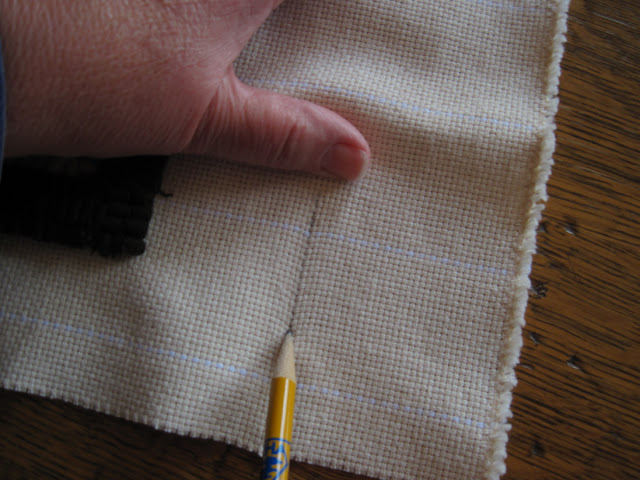| Flip your piece back over. Hey, now you can really see what it's going to look like finished! Let it dry for at least 24 hours before you proceed. IT SHOULD LAY FLAT. Here's it's shown laying on the ironing board. That would be okay if you can do it. If not, or if you're working on a large piece, put down a terry cloth towel(s) and let it lay on the towel to dry. ALSO ... while it's still damp is the time to correct any proportion problems; now is the time to tug a whopper-jawed rug back into shape! Square that rug up now! Some other pointers: don't lay your damp rug on a hardwood or laminate floor, or your nice hardwood table to dry! I don't need to explain that one, right? Relax for awhile and we'll finish tomorrow ...... Also, I always wash my binding tape before I use it. Some black tapes bleed dye and you don't want that happening in the future. I measure what tape I need to go around the edge (remember, measure twice, cut once) and add some for shrinkage. I just swish it around in my bathroom sink with some shampoo, let it soak for awhile, rinse and let it dry over the towel bar. It'll be ready tomorrow when we need it. |
|



































8 comments:
Very Nice! :)
Very helpful and great illustrations of steps :) Thanks so much for sharing!
Rachael
Have you ever used strips of wool instead of the binding tape?
Thank you so much for taking the time to explain this process. It has helped me very much.
Do you know of anyone who does this as a paid service? While I love to hook the rugs, I don't like to bind them!
Your post that documents EXACTLY how to finish a wool hooked (primitive) piece is priceless to me!! I had one row left to hook in my one and only small 7" x 9" piece- Little Sheep. That was nearly 20 yrs ago!! There were no binding directions, so I stopped. I'm going ahead today. THANK YOU!
I loved your step by step instructions to bind a hooked rug! I've bound a few but have so many sitting (rolled up, right side out, lol) waiting to be bound because I'd just forgotten how to do it. Thank you for this very precise tutorial!
Very good instructions. You might want to mention to be sure and wash the tape before hand. It shrinks quite a bit. I have washed a few of my rugs, but was lucky to have pre washed the tape. I have also used wool strips in place of the tape. This works well for a wall hanging.
Post a Comment